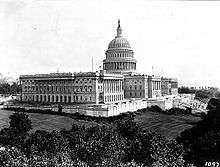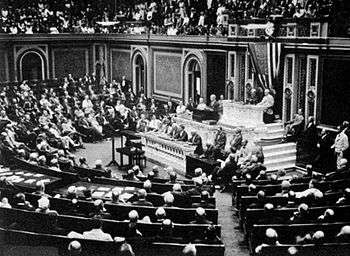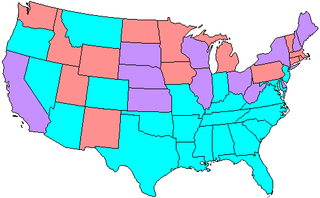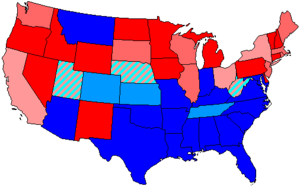64th United States Congress
| 64th United States Congress | |
|---|---|
|
63rd ← → 65th | |
 United States Capitol (1906) | |
| March 4, 1915 – March 4, 1917 | |
| Senate President | Thomas R. Marshall (D) |
| Senate Pres. pro tem |
James Clarke (D) Willard Saulsbury, Jr. (D) |
| House Speaker | Champ Clark (D) |
| Members |
96 senators 435 representatives 5 non-voting delegates |
| Senate Majority | Democratic |
| House Majority | Democratic |
| Sessions | |
|
1st: December 6, 1915 – September 8, 1916 2nd: December 4, 1916 – March 3, 1917 (lame duck) | |
The Sixty-fourth United States Congress was a meeting of the legislative branch of the United States federal government, composed of the United States Senate and the United States House of Representatives. It met in Washington, DC from March 4, 1915, to March 4, 1917, during the third and fourth years of Woodrow Wilson's presidency. The apportionment of seats in the House of Representatives was based on the Thirteenth Census of the United States in 1910. Both chambers had a Democratic majority.
Major events

- June 9, 1915: (Prelude to World War I):U.S. Secretary of State William Jennings Bryan resigned over a disagreement regarding the nation's handling of the RMS Lusitania sinking.
- July 24, 1915: The steamer SS Eastland capsized in central Chicago, with the loss of 844 lives.
- July 28, 1915: The United States occupation of Haiti began.
- August 5–August 23, 1915: Hurricane Two of the 1915 Atlantic hurricane season over Galveston and New Orleans left 275 dead.
- March 8–March 9, 1916: Mexican Revolution: Pancho Villa led about 500 Mexican raiders in an attack against Columbus, New Mexico, killing 12 U.S. soldiers. A garrison of the U.S. 13th Cavalry Regiment fights back and drives them away.
- March 15, 1916: President Woodrow Wilson sent 12,000 United States troops over the U.S.-Mexico border to pursue Pancho Villa.
- May 5, 1916: United States Marines invaded the Dominican Republic.
- July 30, 1916: German agents caused the Black Tom explosion in Jersey City, New Jersey, an act of sabotage destroying an ammunition depot and killing at least 7 people.
- November 7, 1916: U.S. presidential election, 1916: Democratic President Woodrow Wilson narrowly defeated Republican Charles E. Hughes.
- January 11, 1917: (Prelude to World War I): German saboteurs set off the Kingsland Explosion at Kingsland, NJ (now Lyndhurst, NJ), one of the events leading to U.S. involvement in World War I.
- February 3, 1917: (Prelude to World War I):The United States severs diplomatic relations with Germany
Major legislation
- May 15, 1916: Kern Amendment
- May 29, 1916: Fraudulent Advertising Act of 1916
- May 31, 1916: Tillman Act
- June 3, 1916: National Defense Act of 1916
- June 9, 1916: Chamberlain–Ferris Act
- July 11, 1916: Federal Aid Road Act of 1916 (Bankhead–Shackleford Act, also known as Federal "Good Roads" Act)
- July 11, 1916: Terminal Inspection Act of 1916
- July 17, 1916: Federal Farm Loan Act (Hollis–Lever Act)
- July 27, 1916: River and Harbors Act of 1916
- July 28, 1916: Space Basis Act
- July 28, 1916: Railway Mail Service Pay Act
- August 9, 1916: Uniform Bill of Lading Act of 1916
- August 11, 1916: Irrigation District Act of 1916 (Smith Act)
- August 11, 1916: Wildlife Game Refuges Act of 1916
- August 11, 1916: Grain Standards Act of 1916
- August 11, 1916: Cotton Futures Act of 1916
- August 11, 1916: Brush Disposal Act of 1916
- August 11, 1916: Warehouse Act of 1916
- August 25, 1916: National Park Service Act (Kent–Smoot Act)
- August 29, 1916: 2nd Uniform Bill of Lading Act of 1916
- August 29, 1916: Jones Act (Philippines)
- August 29, 1916: Federal Possession and Control Act of 1916
- August 29, 1916: Army Appropriations Act of 1916
- August 29, 1916: Naval Act of 1916
- August 29, 1916: Naval Reserve Force Act
- August 31, 1916: Federal Standard Container Act
- August 31, 1916: Standard Fruits and Vegetable Baskets and Containers Act of 1916
- September 1, 1916: Keating–Owen Act
- September 3, 1916: Adamson Act
- September 7, 1916: Merchant Marine Act of 1916 (Alexander Act)
- September 7, 1916: Workingmen's Compensation Act (Kern–McGillicuddy Act)
- September 8, 1916: Anti-Dumping Act of 1916
- September 8, 1916: Emergency Revenue Act of 1916
- October 20, 1916: Special Air Preparedness Act
- December 29, 1916: Stock-Raising Homestead Act
- February 5, 1917: Immigration Act of 1917
- February 22, 1917: Federal Interpleader Act of 1917
- February 23, 1917: Smith–Hughes Act
- February 26, 1917: Mount McKinley National Park Act of 1917
- March 1, 1917: Flood Control Act of 1917 (Ransdell–Humphreys Act)
- March 2, 1917: Jones–Shafroth Act
- March 3, 1917: Reed Amendment
- March 3, 1917: Sheppard Bone-Dry Act
- March 3, 1917: Special Preparedness Fund Act of 1917
- March 4, 1917: Timber Export Act
Treaties
- January 17, 1917: Treaty of the Danish West Indies signed by President Wilson, ceding the Danish West Indies to the United States after their purchase from Denmark, and renaming them the US Virgin Islands.
Party summary

Senate
| Party (shading shows control) |
Total | Vacant | |||
|---|---|---|---|---|---|
| Democratic (D) |
Republican (R) | Other | |||
| End of the previous congress | 53 | 42 | (Progressive) 1 |
96 | 0 |
| Begin | 56 | 40 | 0 | 96 | 0 |
| End | 55 | 41 | |||
| Final voting share | 57.3% | 42.7% | 0.0% | ||
| Beginning of the next congress | 54 | 42 | 0 | 96 | 0 |
House of Representatives
- Democratic (D): 230 (majority)
- Republican (R): 196
- Progressive (Prog): 6
- Prohibition (Proh): 1
- Socialist (S): 1
- Independent (I): 1
TOTAL members: 435
Leadership
Senate
- President: Thomas R. Marshall
- Presidents pro tempore: James P. Clarke and Willard Saulsbury, Jr.
- Majority Whip: J. Hamilton Lewis (D)
- Minority Whip: Charles Curtis (R)
- Republican Conference Chairman: Jacob Harold Gallinger
- Democratic Caucus Chair : John W. Kern
- Republican Conference Secretary: James Wolcott Wadsworth Jr.
- Democratic Caucus Secretary: Willard Saulsbury Jr., until December 14, 1916
- Key Pittman, acting
House of Representatives
- Speaker: Champ Clark (D)
Majority (Democratic) leadership
Minority (Republican) leadership
Members
Senate
At this time, most sitting Senators had been elected by the state legislatures, with one-third beginning new six-year terms with each Congress. Due to the 17th Amendment, the incoming class of senators from the 1914 election were all elected directly by the residents of their state, In this Congress, Class 1 meant their term ended with this Congress, requiring reelection in 1916; Class 2 meant their term began in the last Congress, requiring reelection in 1918; and Class 3 meant their term began in this Congress, requiring reelection in 1920.
House of Representatives
The names of members of the House of Representatives are preceded by their district numbers.
Changes in membership
The count below reflects changes from the beginning of the first session of this Congress.
Senate
- replacements: 3
- Democratic: 1 seat net loss
- Republican: 1 seat net gain
- deaths: 3
- resignations: 0
- vacancy: 0
- Total seats with changes: 4
| State | Senator | Reason for Vacancy | Successor | Date of Successor's Installation |
|---|---|---|---|---|
| Indiana (3) |
Benjamin F. Shively (D) | Died March 14, 1916. Successor was appointed. | Thomas Taggart (D) | March 20, 1916 |
| Maine (2) |
Edwin C. Burleigh (R) | Died June 16, 1916. Successor was elected. | Bert M. Fernald (R) | September 12, 1916 |
| Arkansas (3) |
James P. Clarke (D) | Died October 1, 1916. Successor was elected. | William F. Kirby (D) | November 8, 1916 |
| Indiana (3) |
Thomas Taggart (D) | Successor was elected. | James E. Watson (R) | November 8, 1916 |
House of Representatives
- replacements: 9
- Democratic: 2 seat loss
- Republican: 3 seat gain
- Progressive: 1 seat loss
- deaths: 8
- resignations: 12
- contested elections: 4
- Total seats with changes: 15
| District | Vacator | Reason for Vacancy | Successor | |
|---|---|---|---|---|
| New York 31st | Vacant | Rep. Edwin A. Merritt died during previous congress | Bertrand Snell (R) | November 2, 1915 |
| New York 36th | Vacant | Rep. Sereno E. Payne died during previous congress | Norman J. Gould (R) | November 2, 1915 |
| Pennsylvania 24th | Vacant | Rep.-elect William M. Brown died during previous congress | Henry W. Temple (R) | November 2, 1915 |
| South Carolina 4th | Joseph T. Johnson (D) | Resigned April 19, 1915 | Samuel J. Nicholls (D) | September 4, 1915 |
| New York 23rd | Joseph A. Goulden (D) | Died May 3, 1915 | William S. Bennet (R) | November 2, 1915 |
| Mississippi 5th | Samuel A. Witherspoon (D) | Died November 24, 1915 | William W. Venable (D) | January 4, 1916 |
| West Virginia 2nd | William Gay Brown Jr. (D) | Died March 9, 1916 | George M. Bowers (R) | May 9, 1916 |
| West Virginia 4th | Hunter H. Moss Jr. (R) | Died July 15, 1916 | Harry C. Woodyard (R) | November 7, 1916 |
| California 10th | William Stephens (Prog.) | Resigned July 22, 1916, after being elected Lieutenant Governor of California | Henry S. Benedict (R) | November 7, 1916 |
| Virginia 7th | James Hay (D) | Resigned October 1, 1916, after being appointed judge of the United States Court of Claims | Thomas W. Harrison (D) | November 7, 1916 |
| Philippines Resident Commissioner | Manuel L. Quezon | Resigned October 15, 1916, after being elected to the Senate of the Philippines | Seat remained vacant until next Congress | |
| Puerto Rico Resident Commissioner | Luis Muñoz Rivera | Died November 15, 1916 | Seat remained vacant until next Congress | |
| Georgia 8th | Samuel J. Tribble (D) | Incumbent died December 8, 1916. Successor elected January 11, 1917. |
Tinsley W. Rucker Jr. (D) | January 11, 1917 |
| South Carolina 5th | David E. Finley (D) | Resigned January 26, 1917. Successor elected February 21, 1917. |
Paul G. McCorkle (D) | February 21, 1917 |
| New York 15th | Michael F. Conry (D) | Died March 2, 1917 | Seat remained vacant until next Congress | |
Committees
Lists of committees and their party leaders, for members (House and Senate) of the committees and their assignments, go into the Official Congressional Directory at the bottom of the article and click on the link (5 links), in the directory after the pages of terms of service, you will see the committees of the Senate, House (Standing with Subcommittees, Select and Special) and Joint and after the committee pages, you will see the House/Senate committee assignments in the directory, on the committees section of the House and Senate in the Official Congressional Directory, the committee's members on the first row on the left side shows the chairman of the committee and on the right side shows the ranking member of the committee.
Senate
|
|
House of Representatives
|
|
Joint committees
- Conditions of Indian Tribes (Special)
- Fiscal Relations between the District of Columbia and the United States
- Disposition of (Useless) Executive Papers
- Interstate Commerce
- Interstate and Foreign Commerce
- Rural Credits
Caucuses
- Democratic (House)
- Democratic (Senate)
Employees
- Architect of the Capitol: Elliott Woods
- Librarian of Congress: Herbert Putnam
- Public Printer of the United States: Cornelius Ford
Senate
- Chaplain: F. J. Prettyman (Methodist)
- Secretary: James M. Baker
- Sergeant at Arms: Charles P. Higgins
House of Representatives
- Chaplain: Henry N. Couden
- Clerk: South Trimble
- Clerk at the Speaker’s Table: Bennett C. Clark
- Doorkeeper: Joseph J. Sinnott
- Reading Clerks: Patrick Joseph Haltigan (D) and N/A (R)
- Postmaster: William M. Dunbar
- Sergeant at Arms: Robert B. Gordon
See also
- United States elections, 1914 (elections leading to this Congress)
- United States elections, 1916 (elections during this Congress, leading to the next Congress)
References
- Gould, Lewis L. (2005). The Most Exclusive Club. Cambridge, MA: Perseus Books Group. ISBN 0-465-02778-4.
- Remini, Robert V. (2006). The House. New York: HarperCollins Publishers, Inc. ISBN 0-06-088434-7.
- U.S. Congress (2005). "Biographical Directory of the U.S. Congress". Archived from the original on 1 June 2006. Retrieved 2006-06-01.
- U.S. House of Representatives (2006). "Congressional History". Archived from the original on 1 June 2006. Retrieved 2006-06-01.
- U.S. Senate (2006). "Statistics and Lists". Archived from the original on 1 June 2006. Retrieved 2006-06-01.
- Official Congressional Directory for the 64th Congress, 1st Session.
- Official Congressional Directory for the 64th Congress, 1st Session (1st Revision).
- Official Congressional Directory for the 64th Congress, 1st Session (2nd Revision).
- Congress, United States (1916). Official Congressional Directory for the 64th Congress, 2nd Session.
- Official Congressional Directory for the 64th Congress, 2nd Session (Revision).
